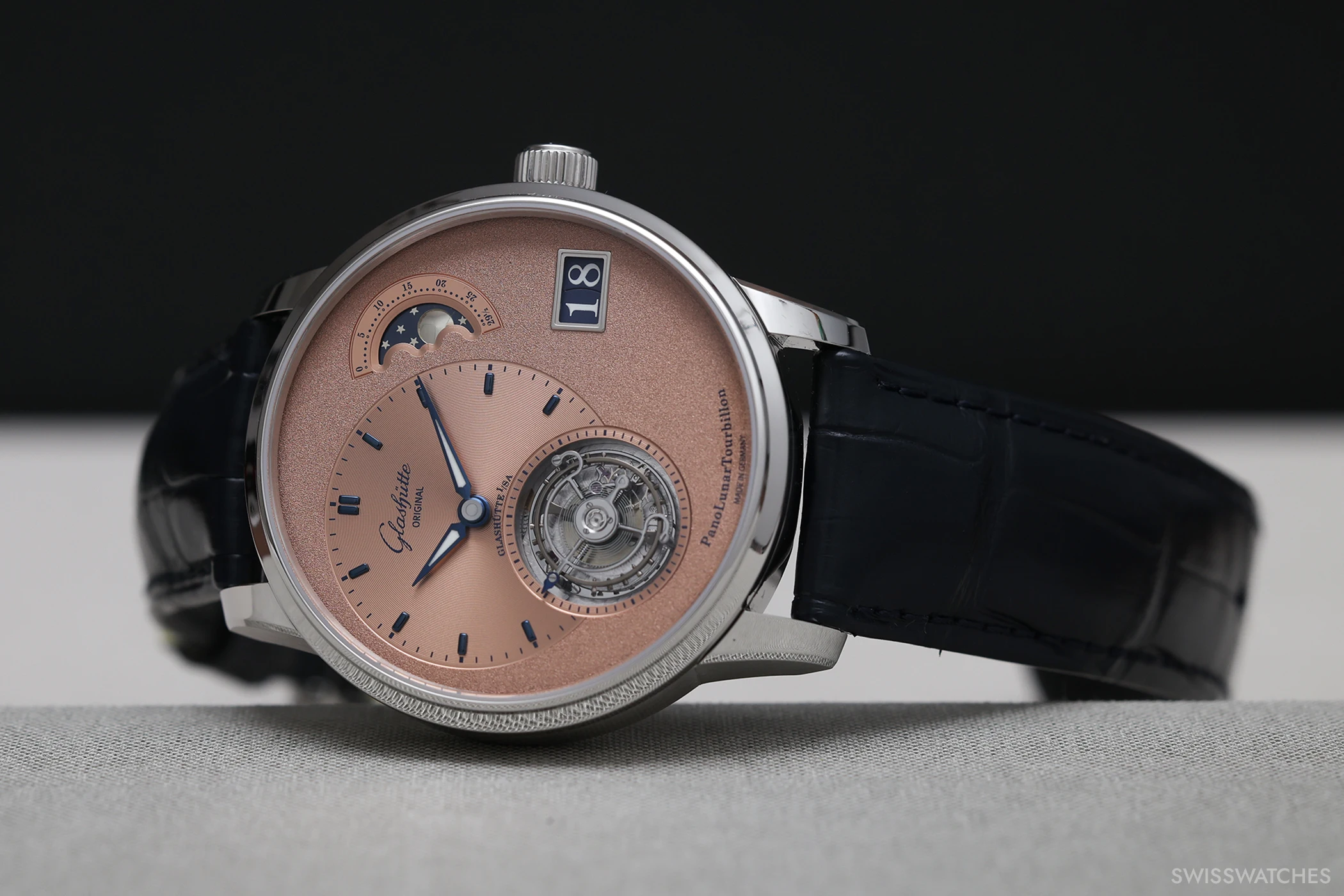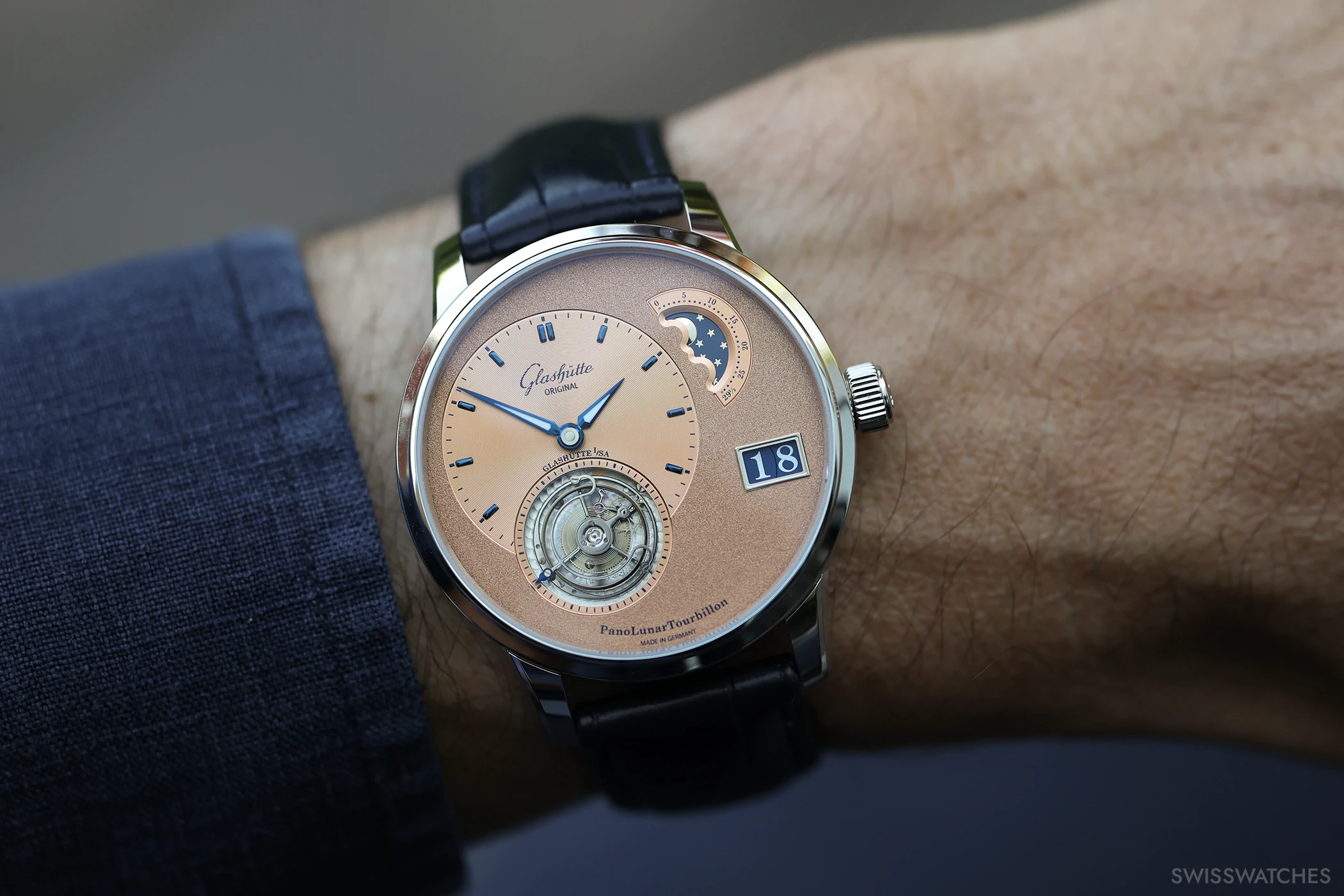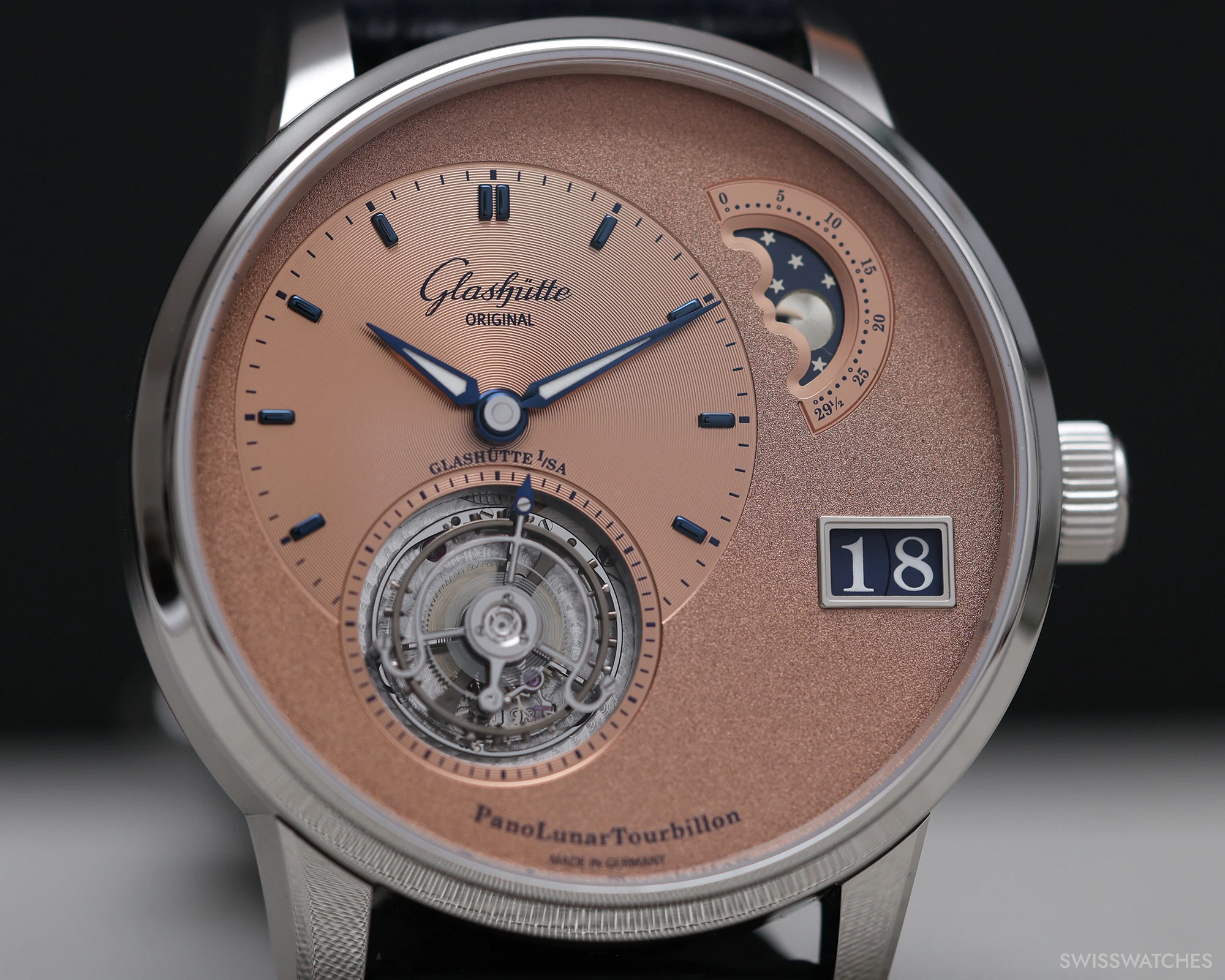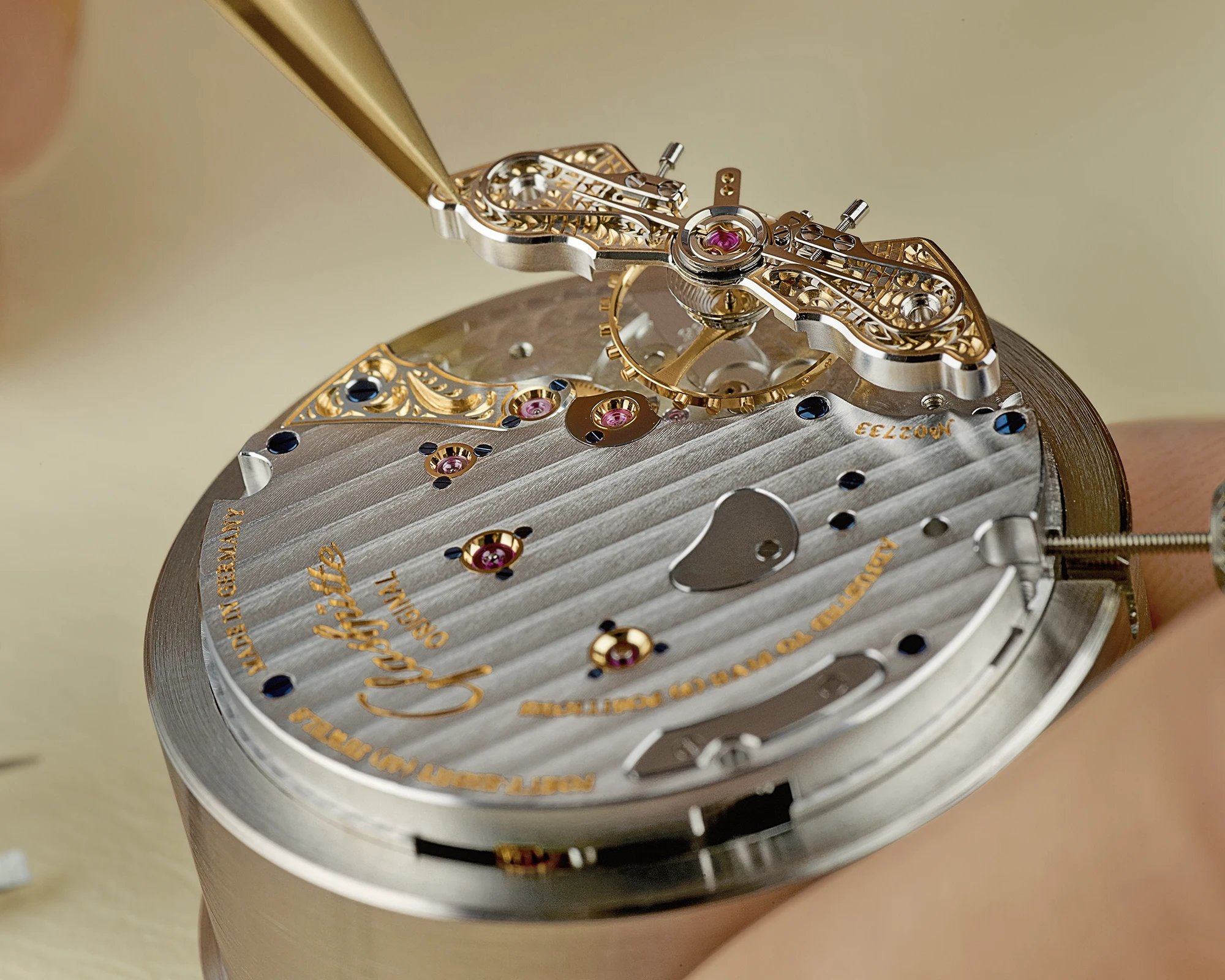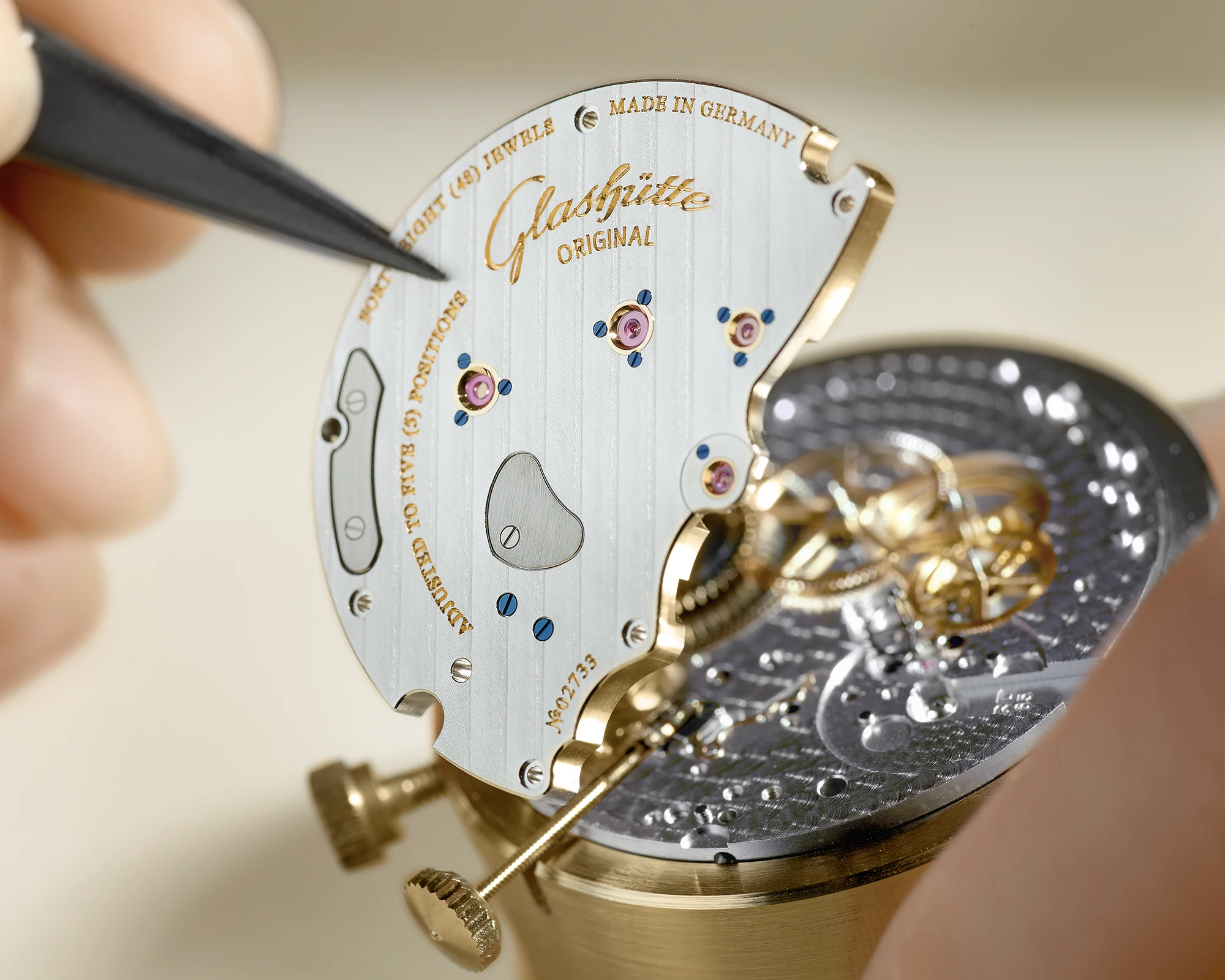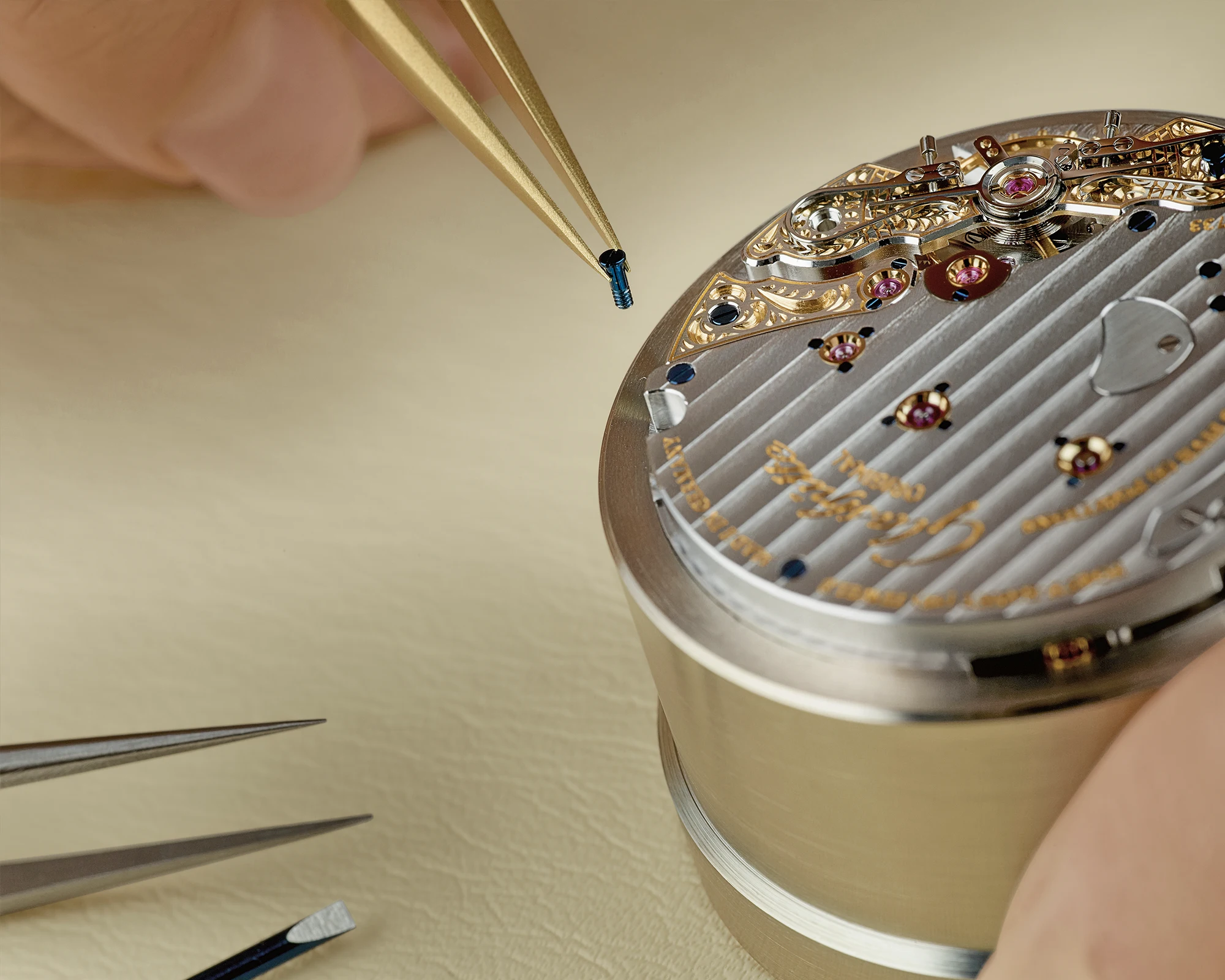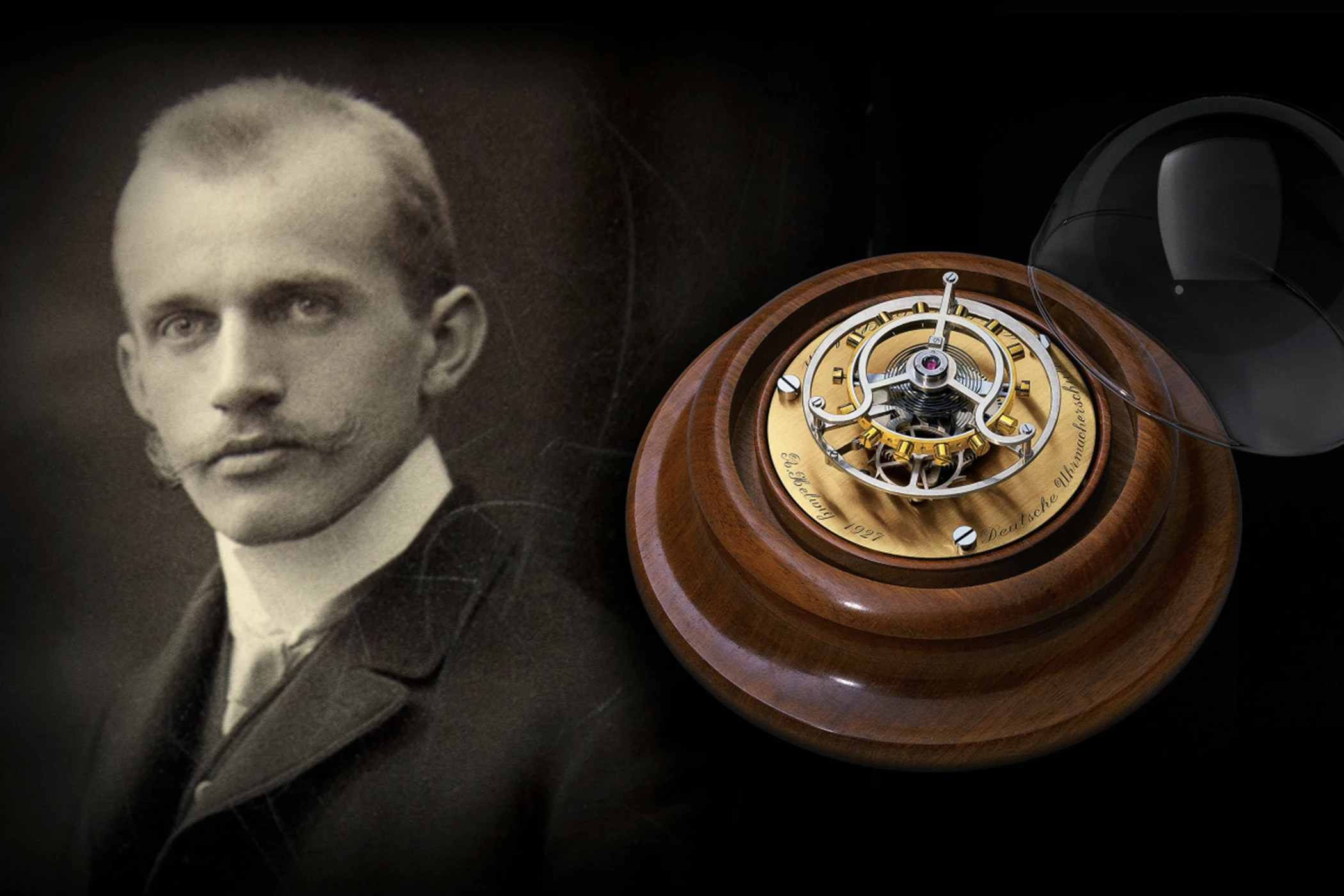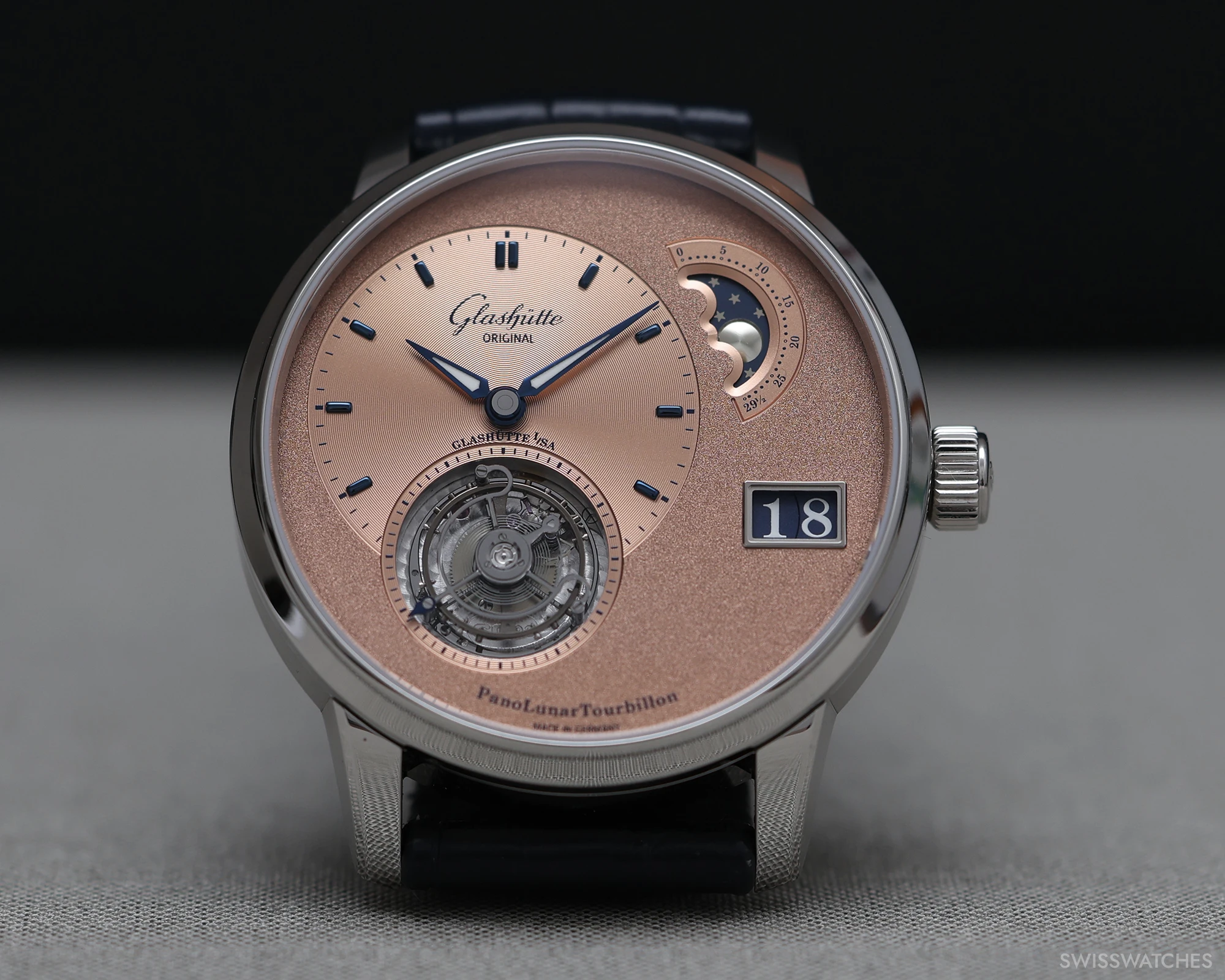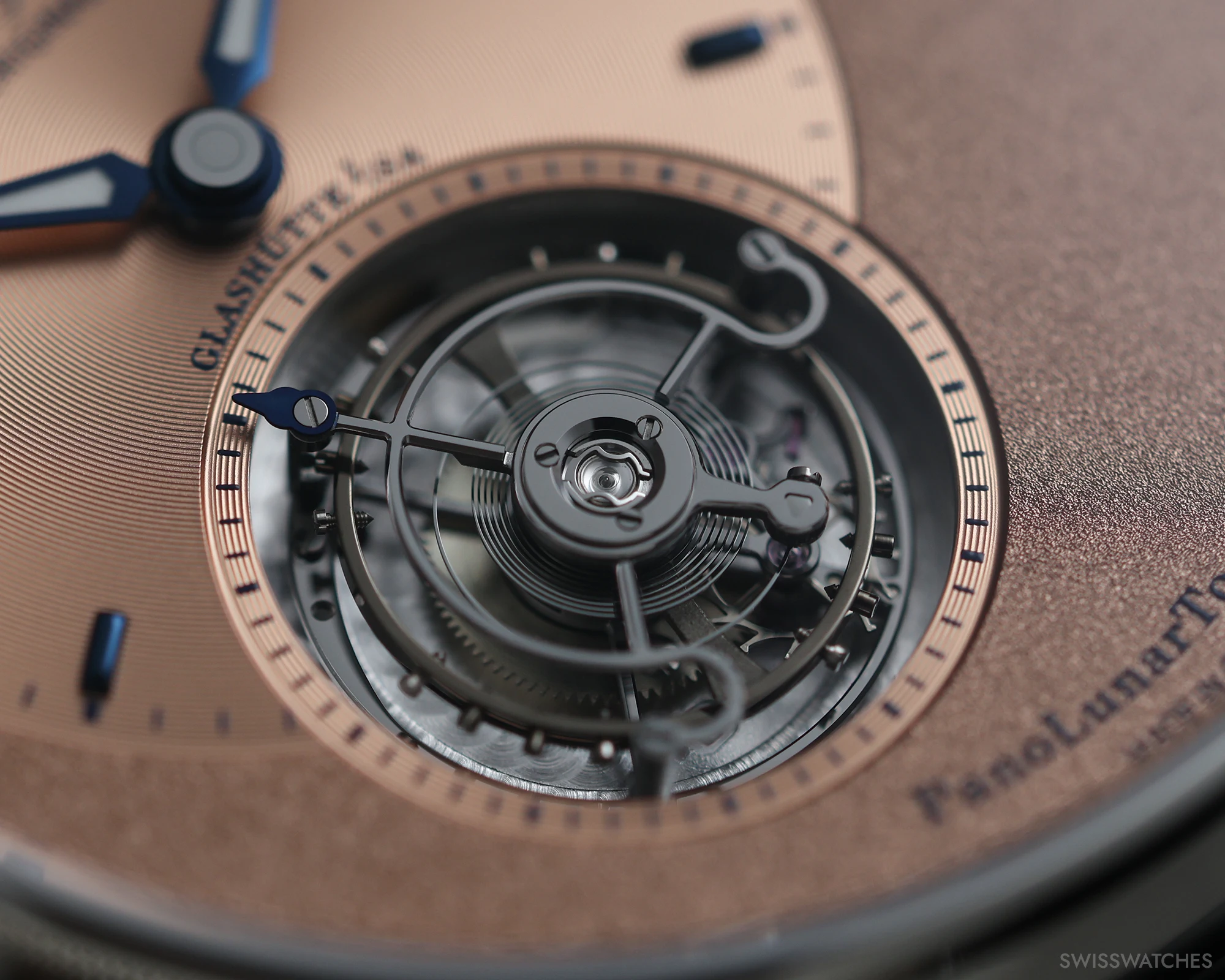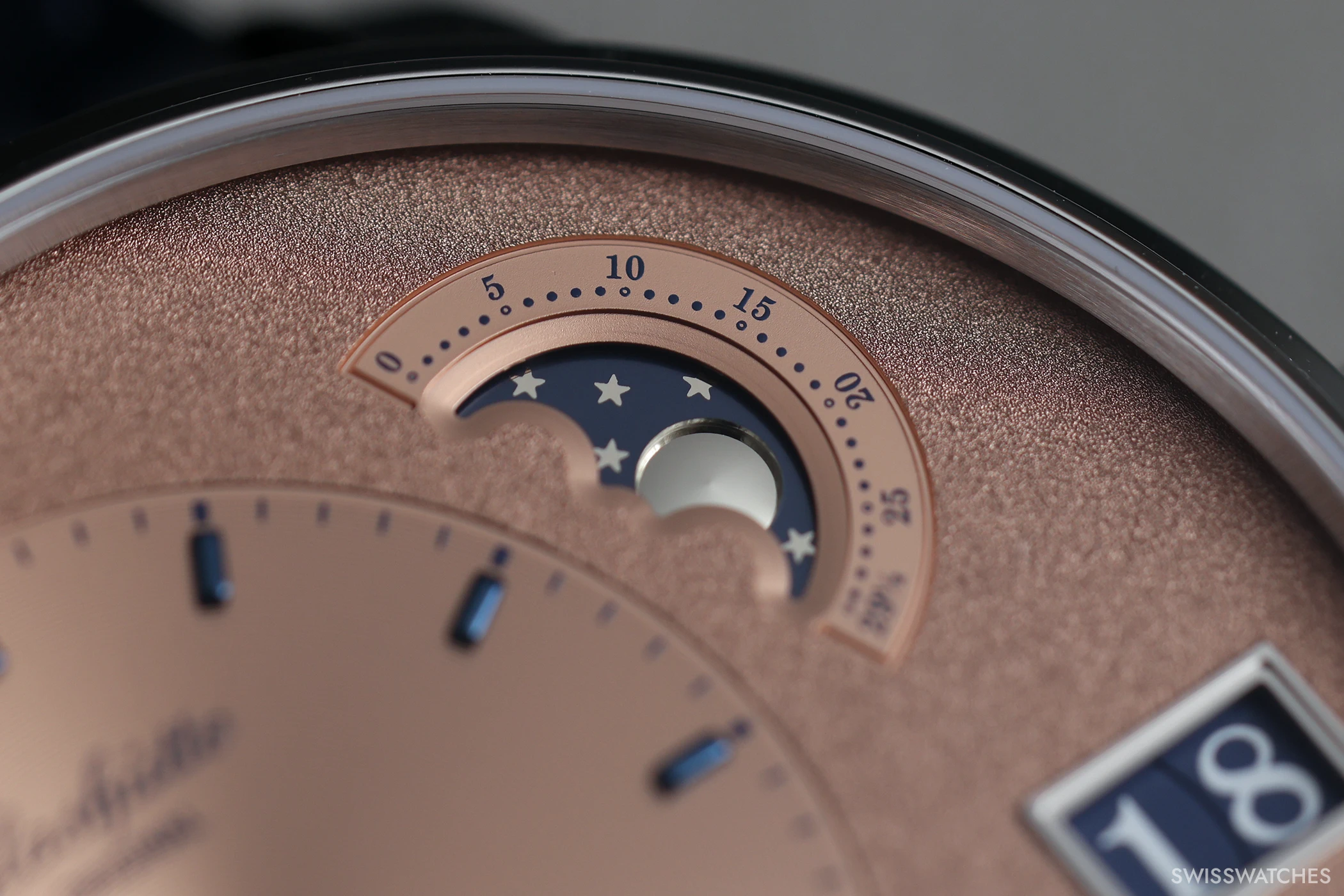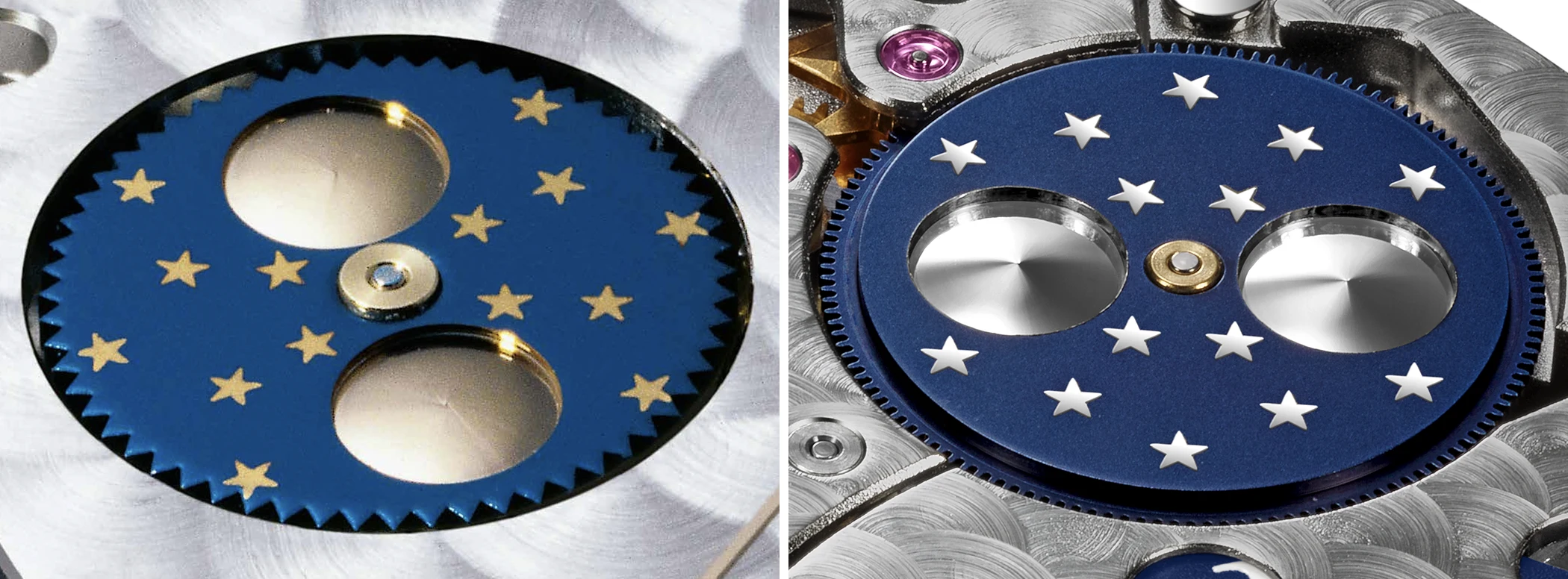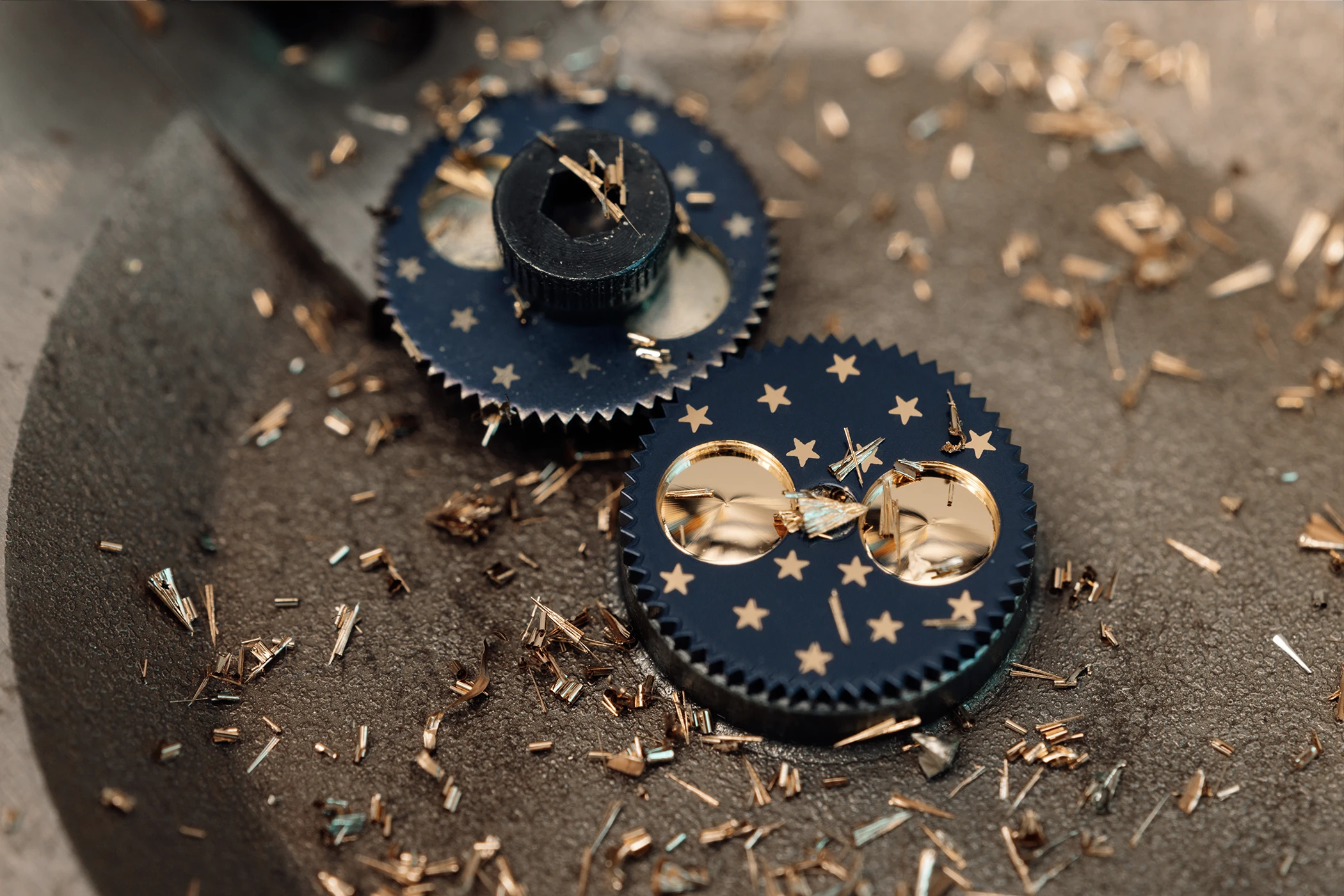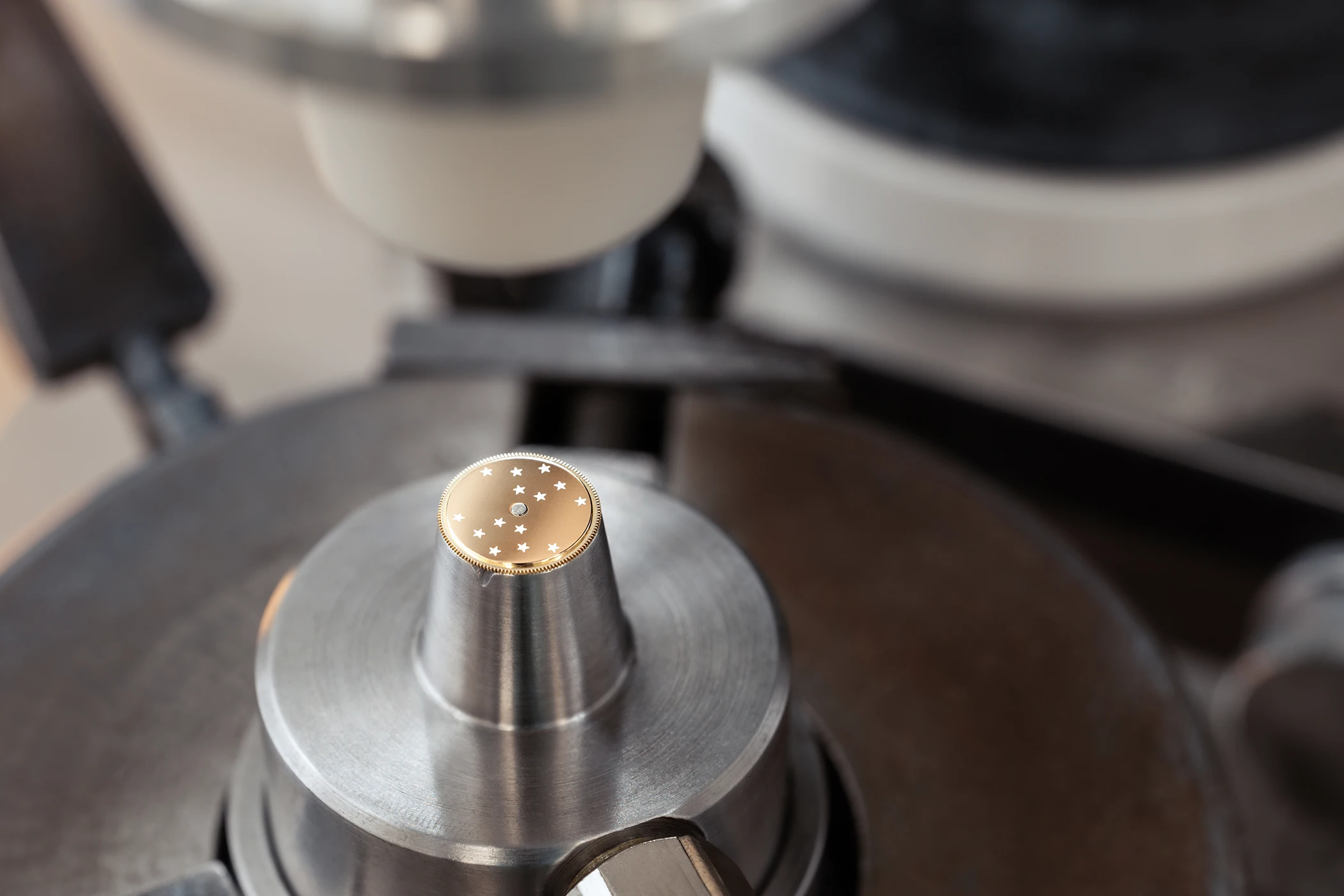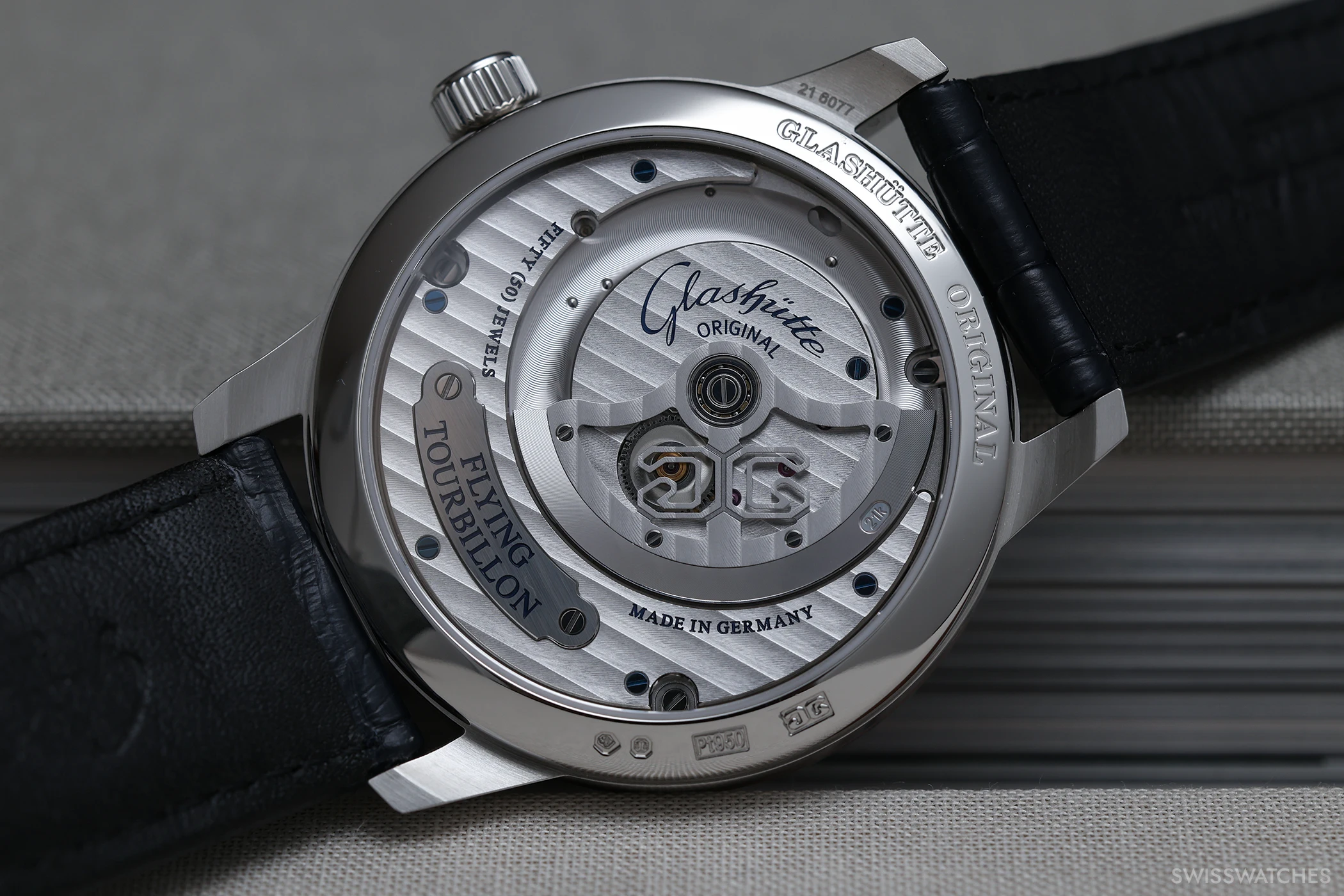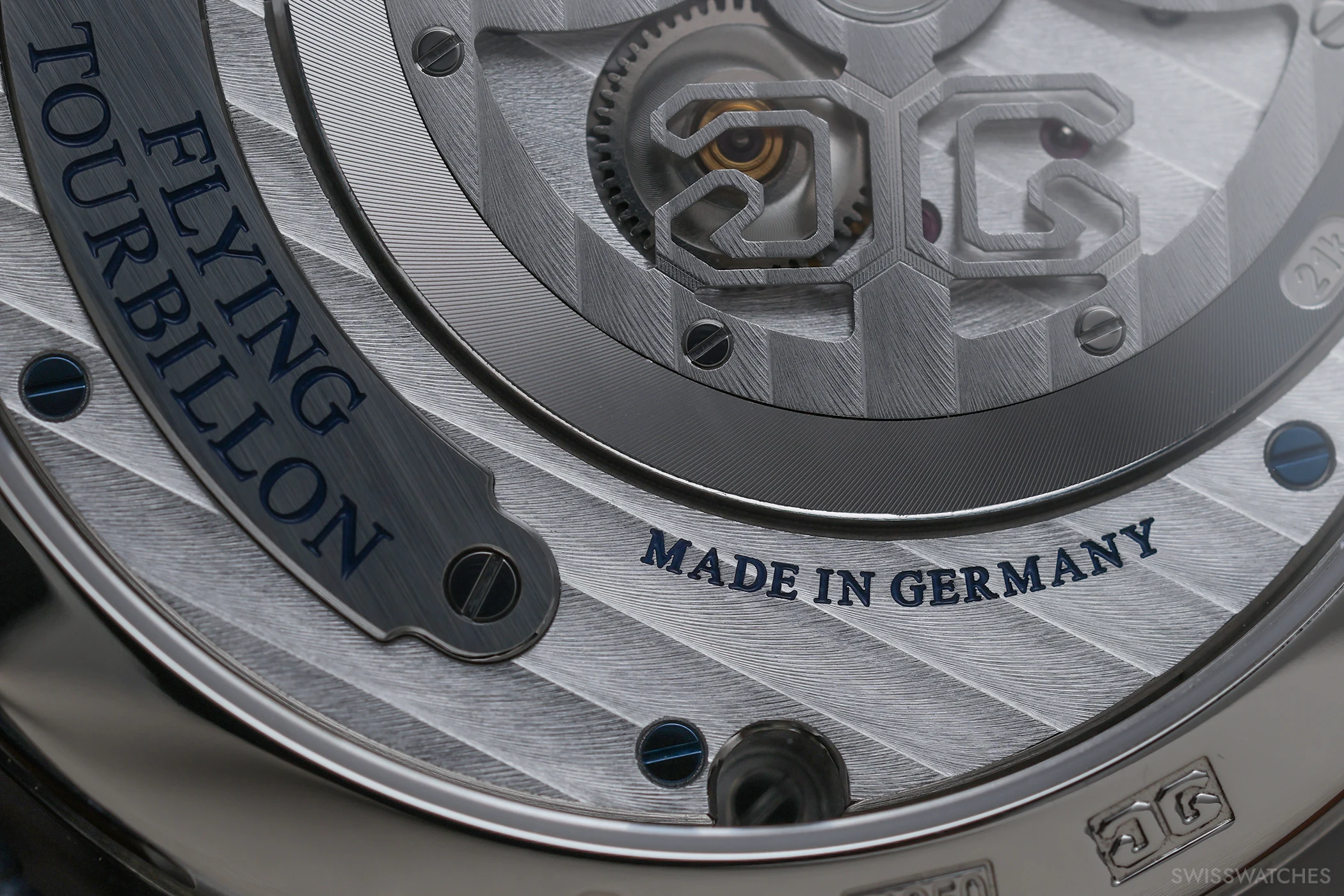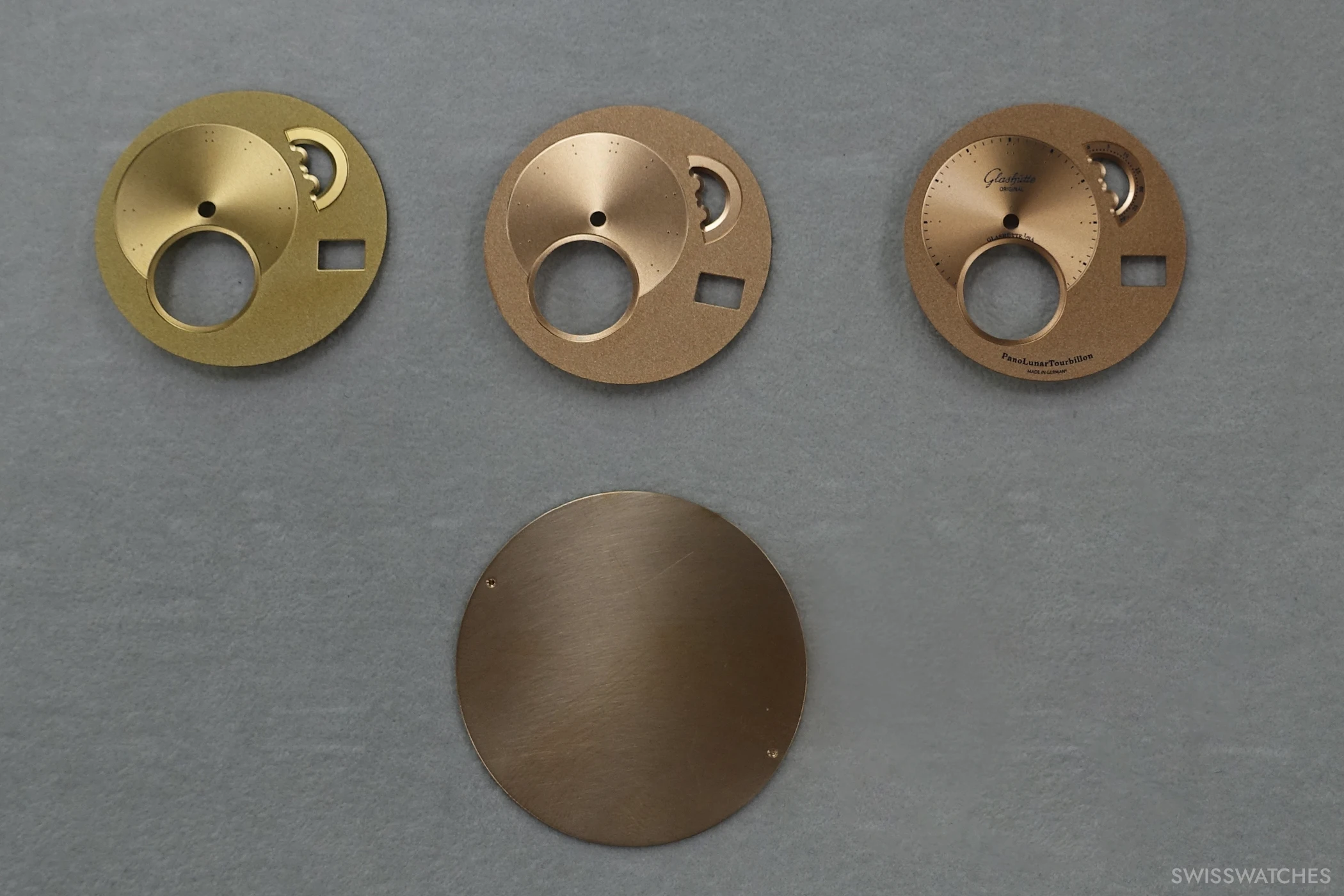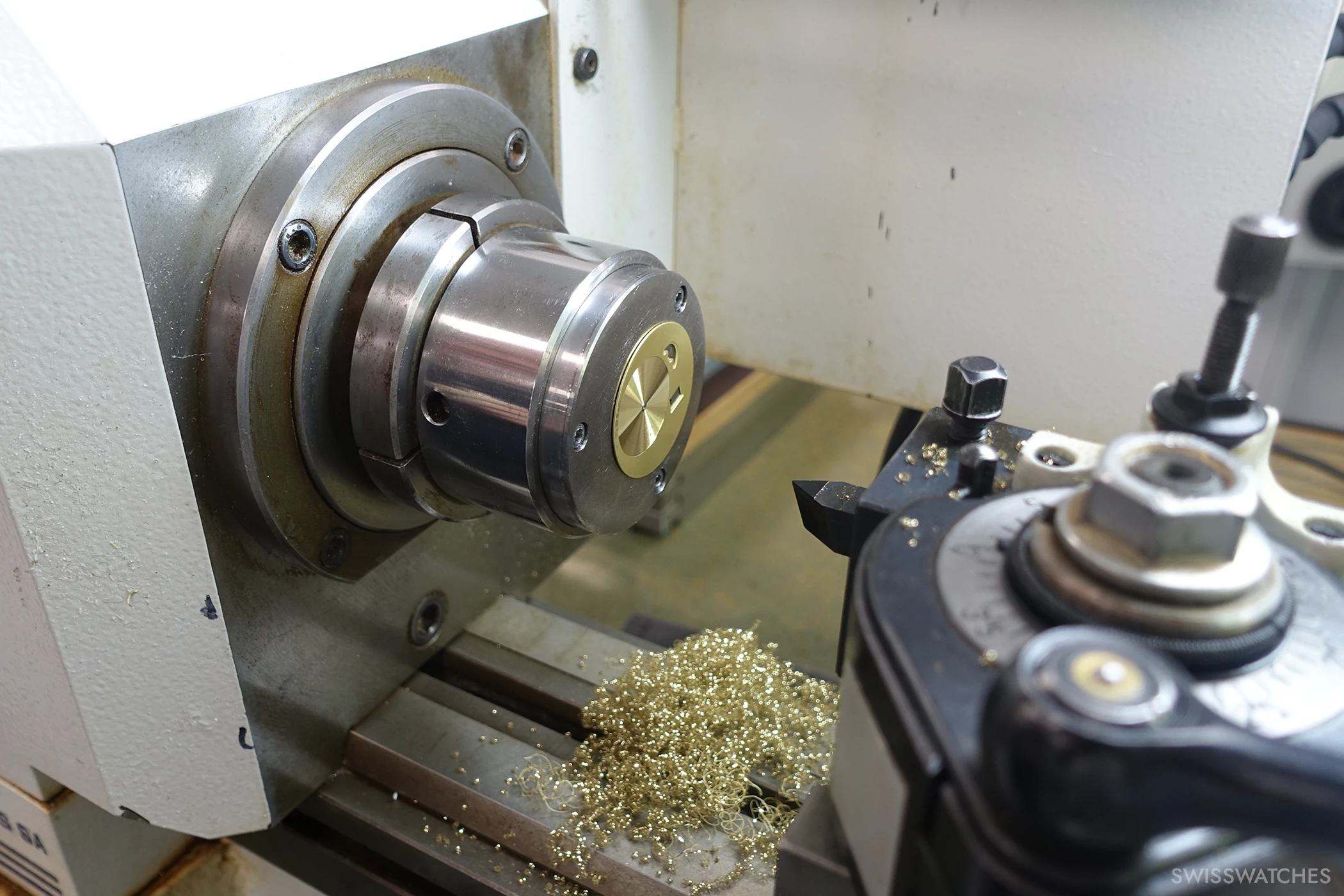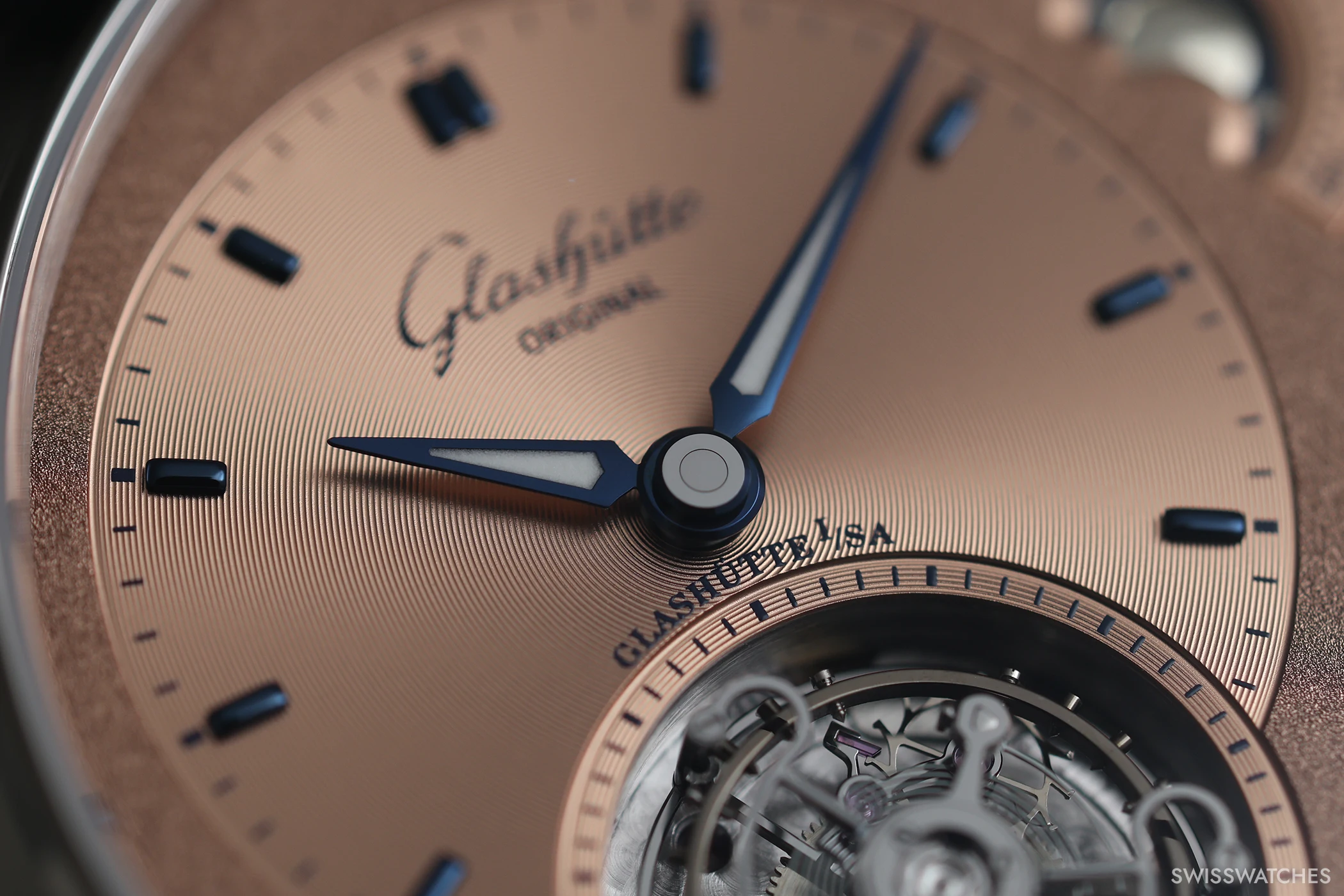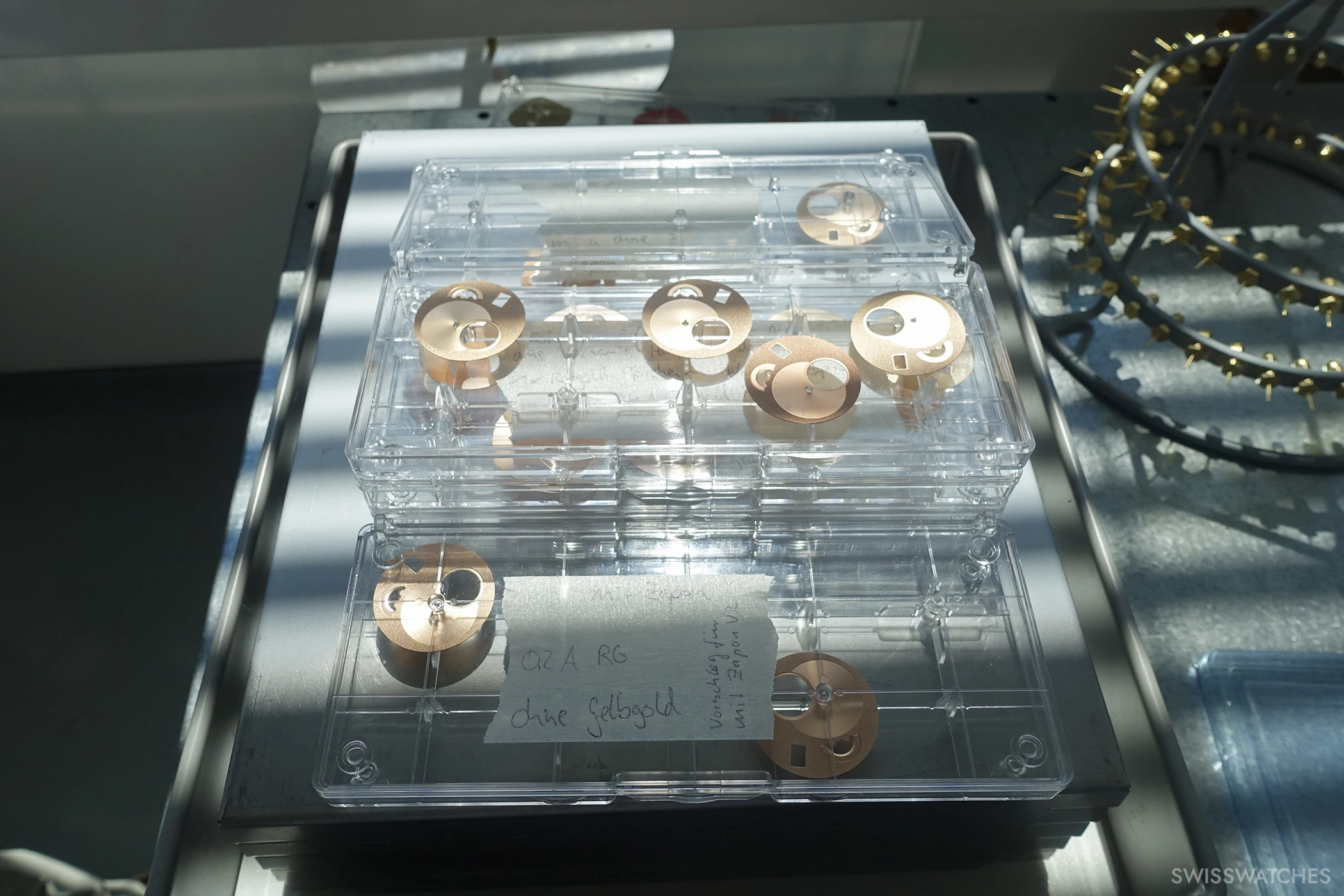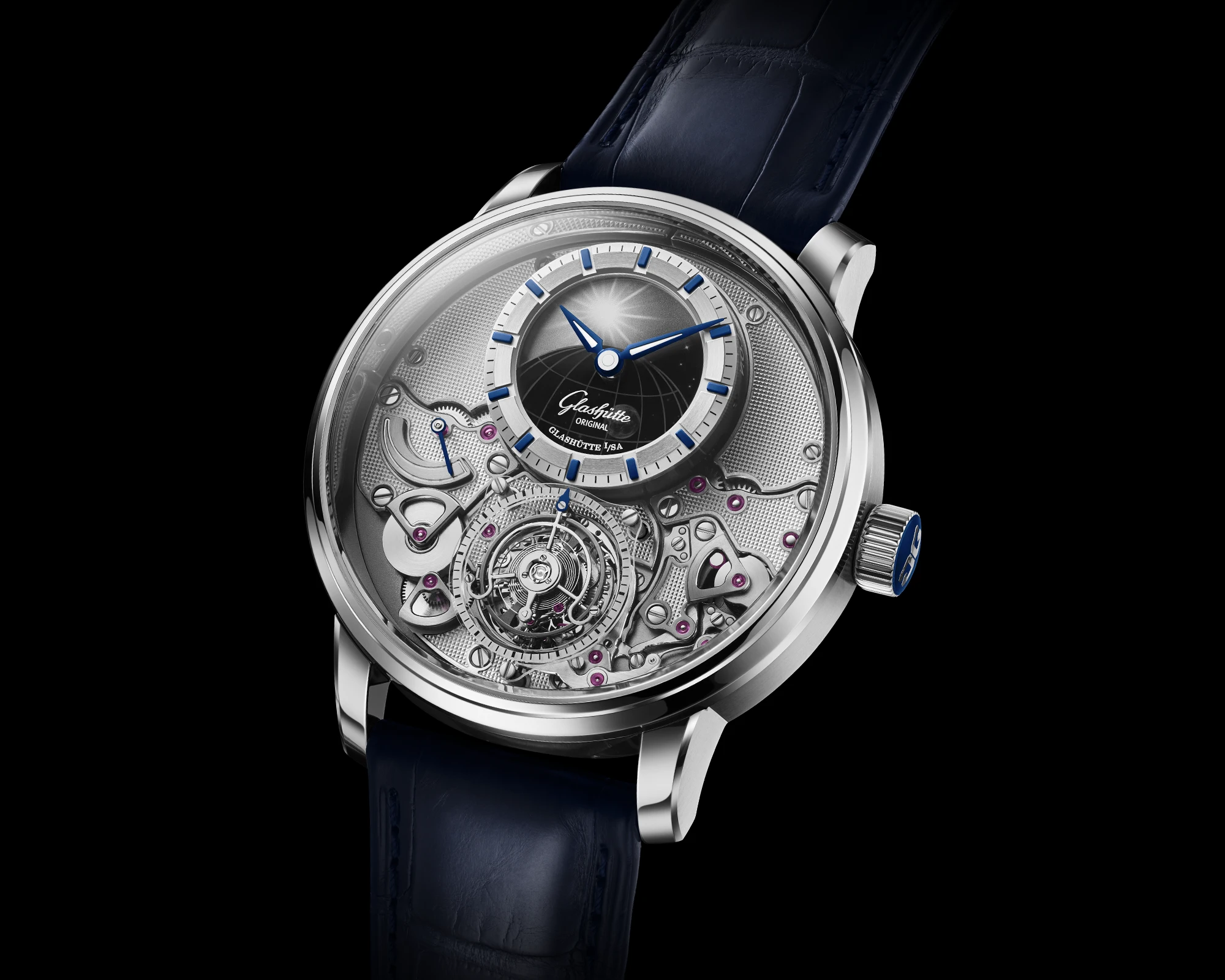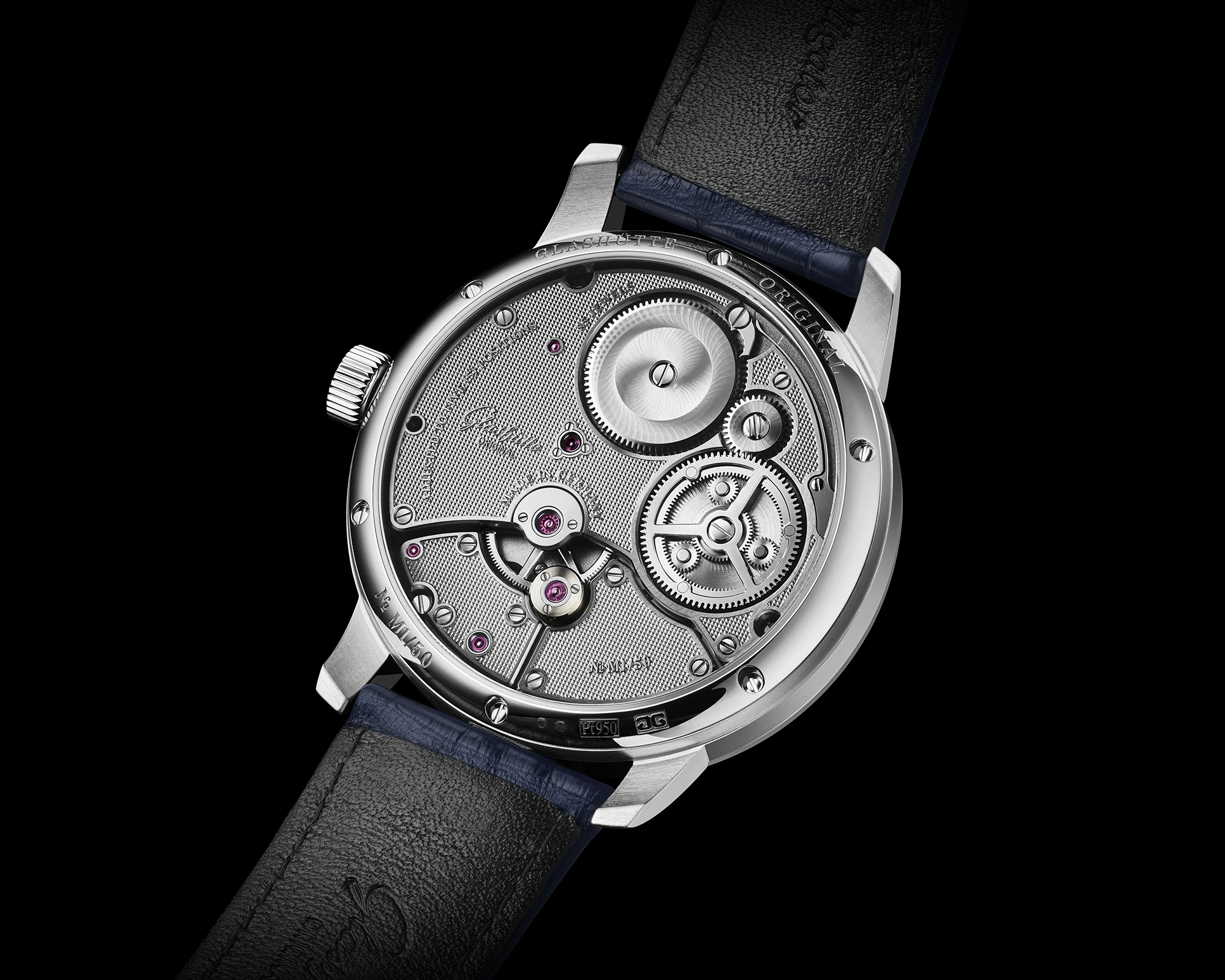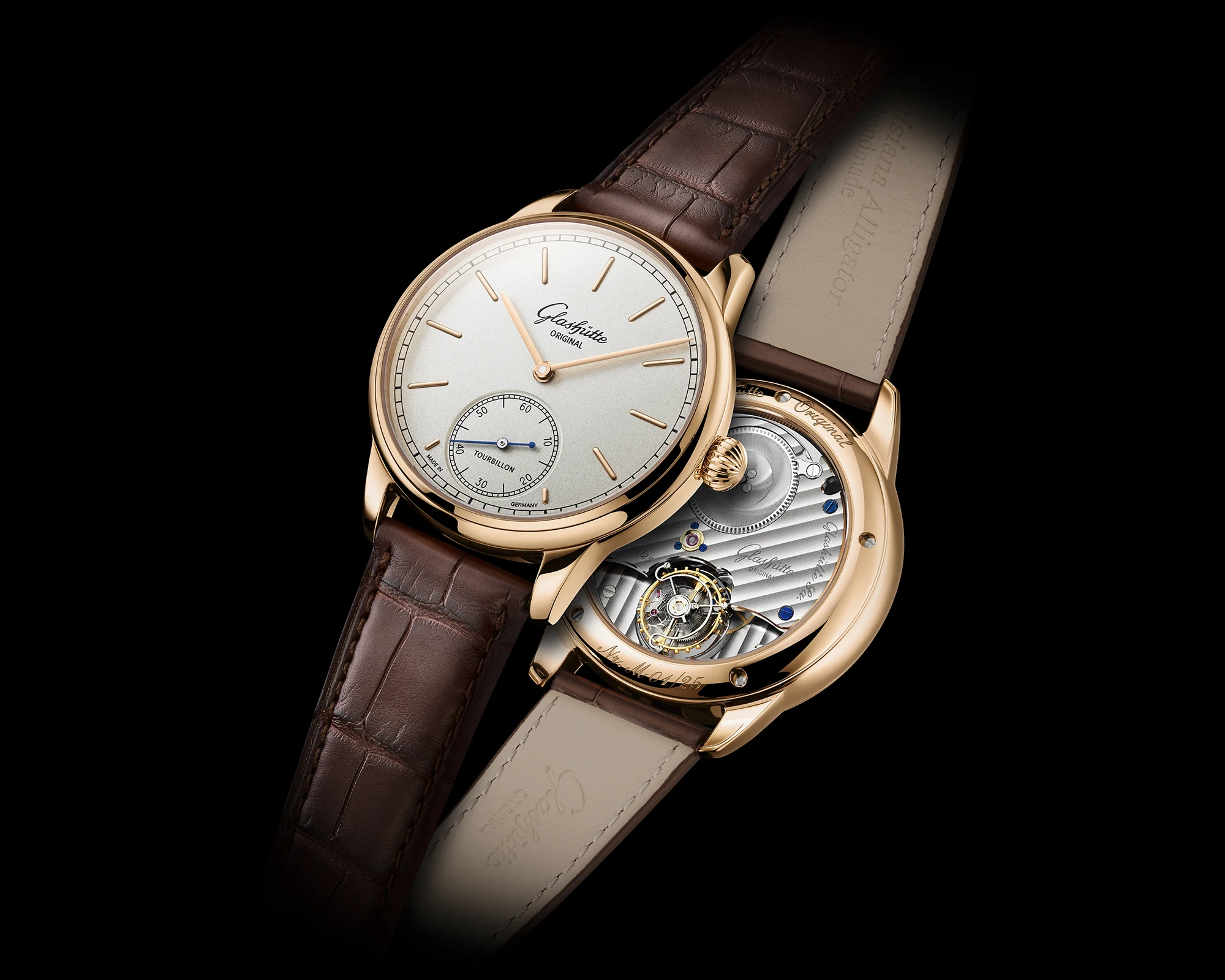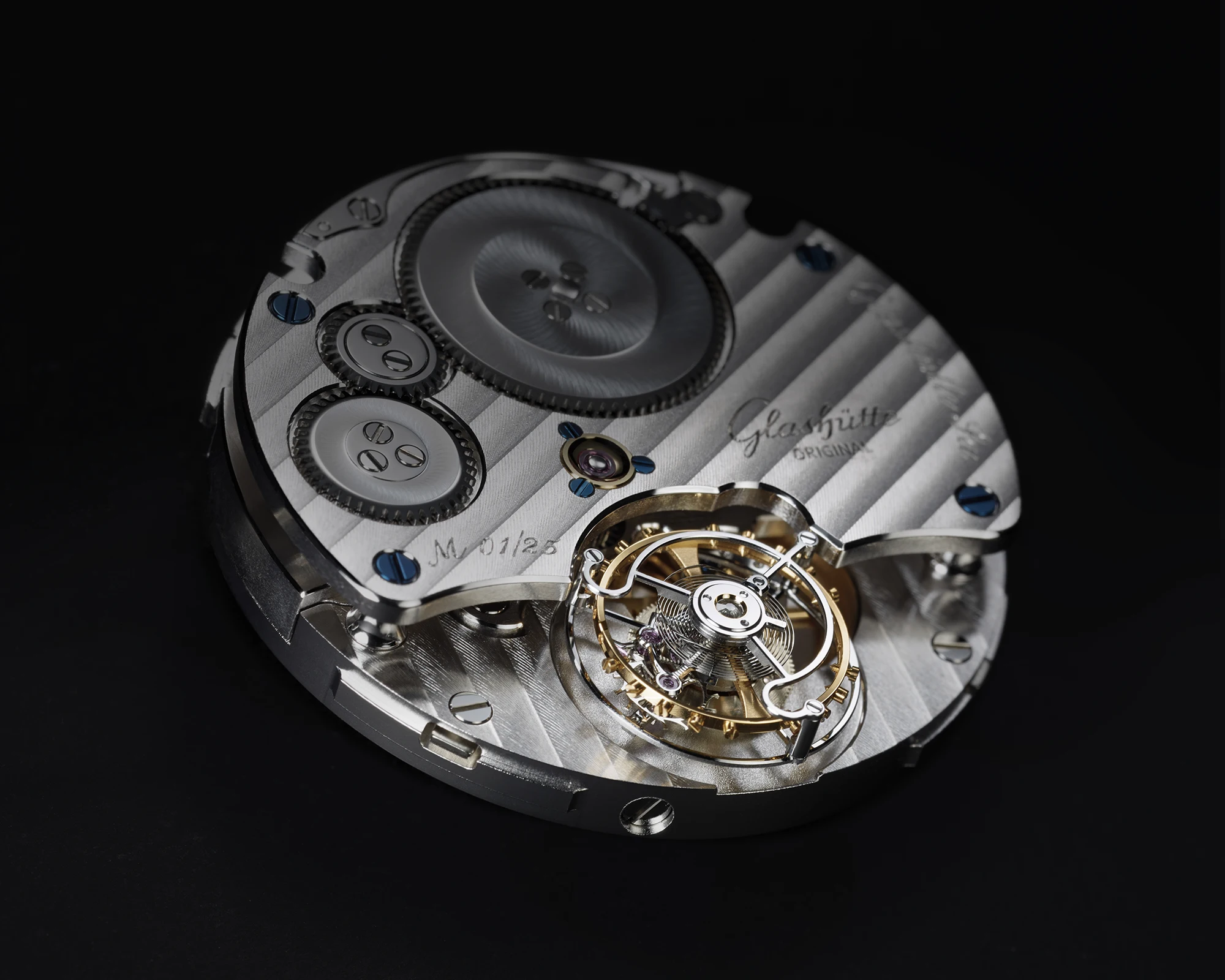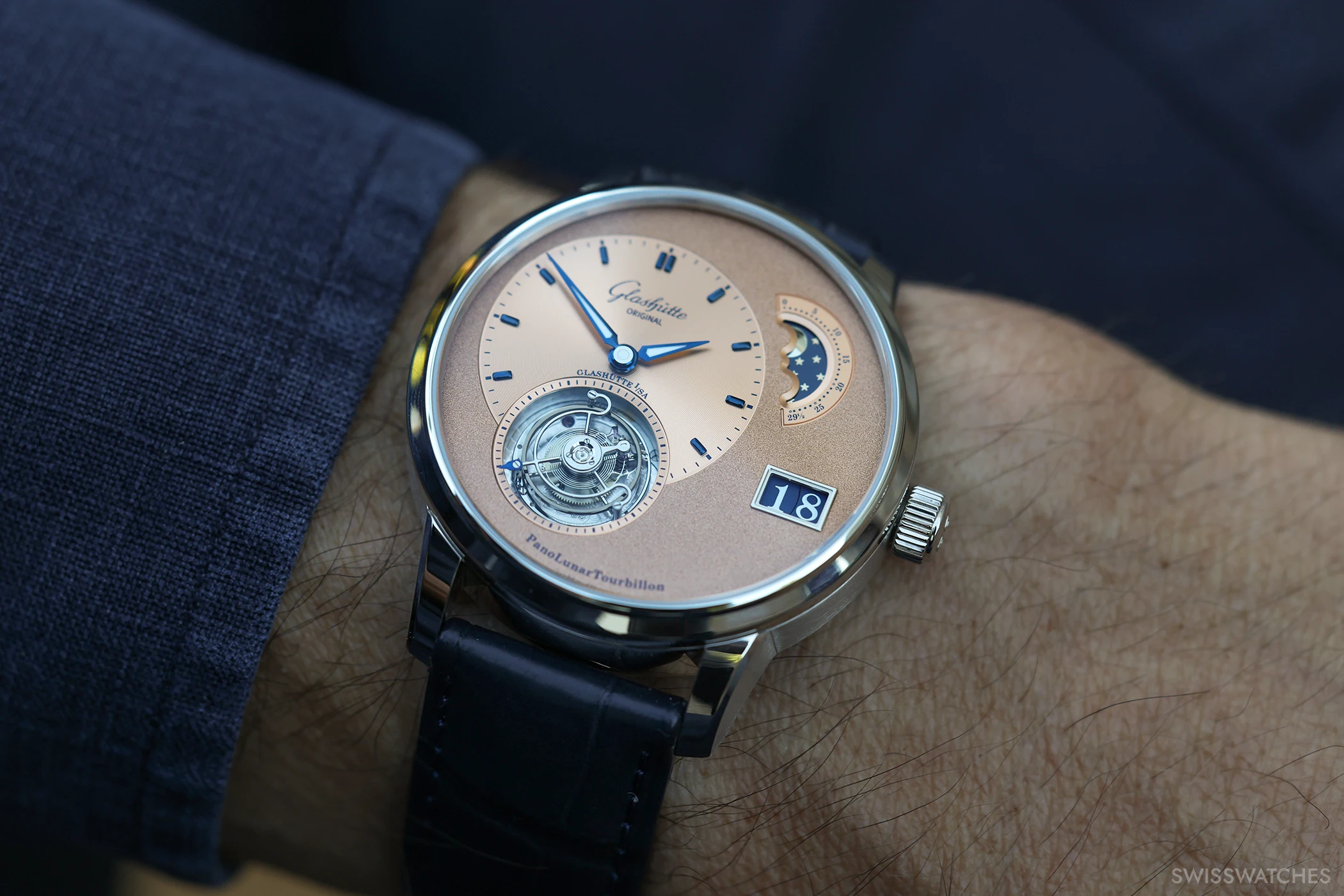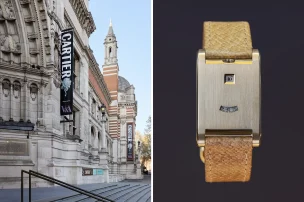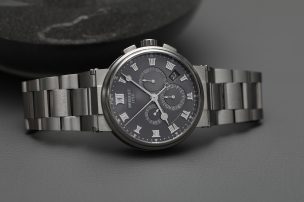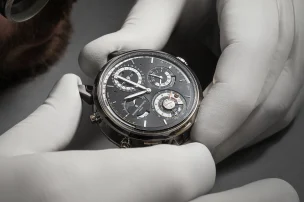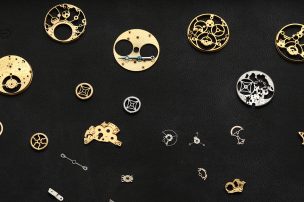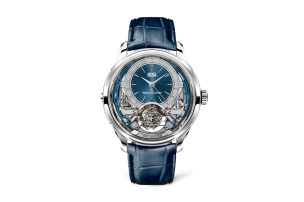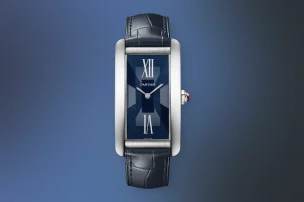
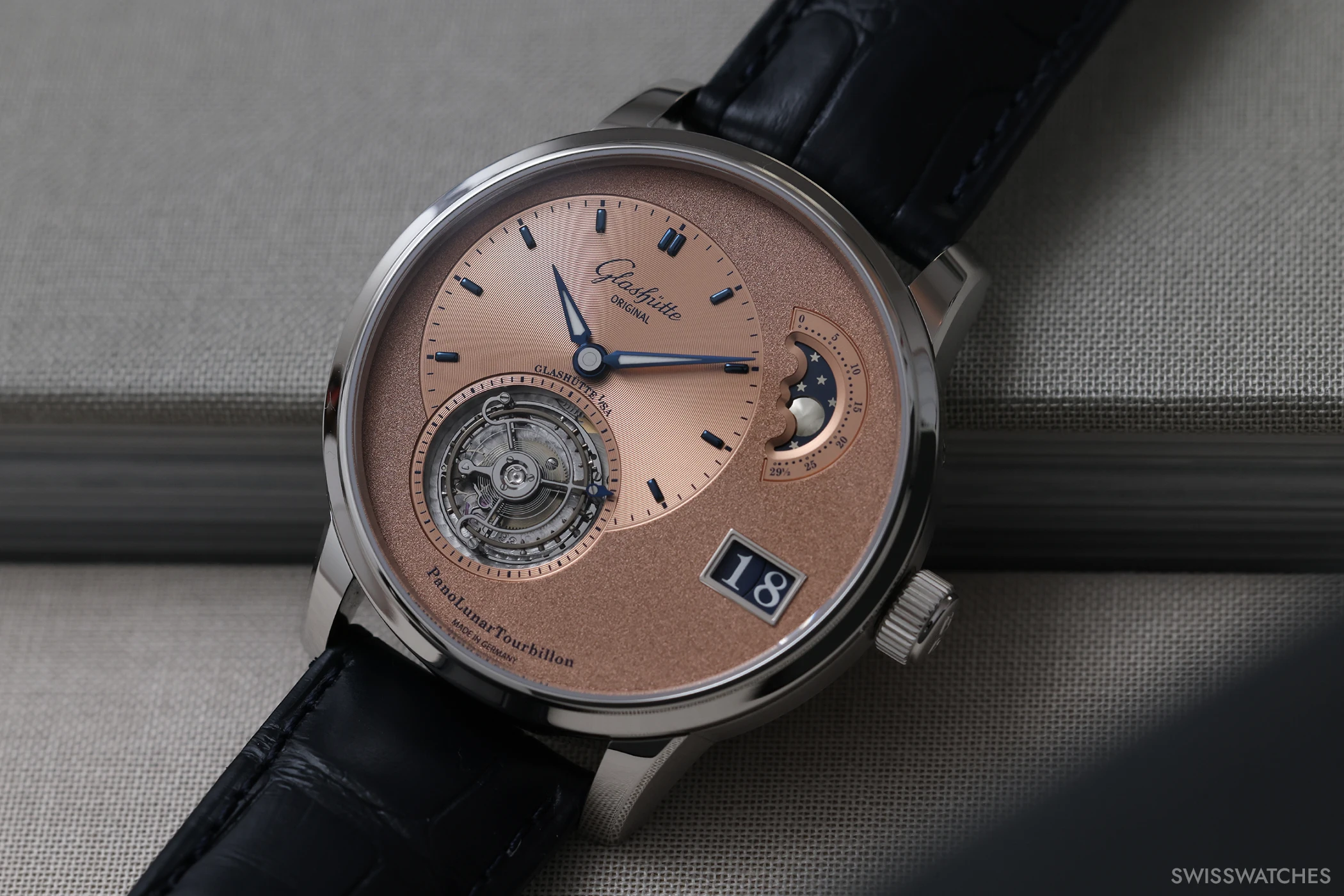
The New Glashütte Original PanoLunarTourbillon as a Reflection of Glashütte Identity
Glashütte Original is celebrating the 180th anniversary of fine watchmaking in Glashütte, as well as the inauguration of a new dial manufactory. To mark this occasion, the brand presents the new PanoLunarTourbillon—a limited edition model that combines a dial inspired by the nature of the Ore Mountains with the traditional complication of the flying tourbillon.
This year, Glashütte Original not only commemorates 180 years of watchmaking in the Saxon town of Glashütte but also opens a second manufacturing building dedicated exclusively to the production of dials. Fittingly, the brand unveils a new timepiece that pays tribute both to Glashütte’s horological heritage and to the region’s characteristic landscape. The highlight of the PanoLunarTourbillon is a new dial inspired by the Ore Mountains, paired with a flying tourbillon — a traditional speciality of the manufacture. We have taken a closer look at the latest flying tourbillon and at the impressive level of vertical integration that Glashütte Original achieves, not only in its movements but also in its in-house dial making and moon phase display.
The New PanoLunarTourbillon: Three Glashütte Specialities
Among watch enthusiasts, there is a common belief that a watch is always more than the sum of its parts. Beyond simply telling the time, a fine timepiece often embodies craftsmanship, technical innovation, or a remarkable origin story. As part of the new dial manufactory’s opening, Glashütte Original presents a creation that lives up to this ideal: at its heart is a new dial, inspired by the natural surroundings of Glashütte and testament to the manufacture’s artisanal expertise. For those wishing to delve deeper into the world of Glashütte Original and its commitment to the highest standards of watchmaking, we recommend our detailed manufactory feature.
The inspiration for the new rose-coloured dial is drawn from the reddish soil found around the watchmaking town of Glashütte. This distinctive hue is the result of hematite — a mineral iron oxide — which formed through the oxidation of iron-bearing rock, gradually accumulating in the earth over millions of years of prevailing tropical climate. Even today, intense red discolourations can be seen on fields and embankments in the Eastern Ore Mountains — for example, near Dippoldiswalde, in the Paulsdorfer Heide, or at the so-called “Red Hill” near Crandorf.
The principal allure of the models in the Pano collection lies in a dial design that has become emblematic of the brand, earning the reputation of the “German Watchface.” Based on the Golden Ratio, this design is distinguished by the off-centre arrangement of the larger hour and smaller subsidiary seconds dials on one side, balanced on the opposite side by a moon phase display and the signature panorama date. The same combination of unconventional yet aesthetic design is embodied in the new PanoLunarTourbillon, which features a rose-coloured dial paired with blued indices and blued hands. The subsidiary seconds is now replaced by the flying tourbillon, with the small seconds displayed atop the tourbillon cage, indicated by a delicate blue-tipped arrow. The panorama date — a feature developed by Glashütte Original in 1997 and positioned at four o’clock — displays white numerals against a blue background, framed by a silver border.
The Flying Tourbillon and Its Significance for Glashütte Original
Before examining the flying tourbillon in detail, it is worth taking a look at Glashütte Original’s manufacturing processes — the very foundation upon which technical achievements such as this are built. Across the four light-filled storeys of the manufacture, nearly every stage of production, from concept to finished product and from the smallest screw to the completed dial, is regarded as a core competence. At Glashütte Original, “doing it yourself” means producing every gear, the finest pinions and levers, and even the watchmakers’ tools and certain machines in-house. Only a handful of components — such as the balance spring, mainspring, jewels, and some dial appliqués — are sourced from external suppliers. The result of these efforts is a level of vertical integration which, according to the brand, exceeds 95 percent.
This remarkable depth of manufacturing extends to the flying tourbillon, which today, alongside the perpetual calendar of the Senator collection and the world time function of the Senator Cosmopolite, sits at the very pinnacle of Glashütte Original’s complications. One of the reasons for its significance is found in the town’s own history, for nowhere embodies German watchmaking more than Glashütte itself: it was here, in 1920, that master watchmaker Alfred Helwig invented the flying tourbillon at the local watchmaking school. This refinement of the Breguet tourbillon is characterised by the exclusive support of the tourbillon cage from beneath, in which the entire oscillating and escapement system of a mechanical watch is housed. By dispensing with the upper bridge, the tourbillon appears to “fly”.
Today, the flying tourbillon stands as a hallmark of Glashütte Original’s most prestigious complications, and is the focus of continual development — most recently, for example, with innovations and patents such as the flying tourbillon with a zero-reset mechanism in the Senator Chronometer Tourbillon of 2019 (but more on that later). At Glashütte Original, production of a flying tourbillon begins with wire erosion, in which the intricate components of the tourbillon cage are first precisely cut — using a process whereby a wire “melts” away metal by means of electrical current. However, the real challenge in making a tourbillon lies in the polishing and angling of its parts. Of the 72 components that make up the tourbillon — excluding the pillars — all surfaces are tin-flat polished and the edges are hand-chamfered to a 45-degree angle, a process in which the tin-flat polishing alone can require six to eight hours. In the end, the tourbillon, weighing a mere 0.2 grams, will have required several days of painstaking work. Of particular note is that, at Glashütte Original, each major complication — including the tourbillon — is assembled and overseen from start to finish by a single watchmaker.
The Moon Phase Display of the PanoLunarTourbillon
Another central feature among the typical complications of a Glashütte Original timepiece is the moon phase display, which, in the new PanoLunarTourbillon, appears as a combination of a deep blue night sky and silver celestial bodies. Beneath the moon phase aperture, two moons are revealed — an arrangement that relates to the length of a lunar cycle, which is around 29.5 days. However, since mechanical movements operate most precisely with whole numbers, the most widely used method for depicting the moon phase involves doubling this figure to achieve an even 59 days. This double representation allows the moon phase disc to correspond with the daily cycle (24 hours), as the disc completes one full rotation every 59 days. The use of two moons ensures that one lunar body is always visible in the display window.
The PanoLunarTourbillon, however, features a special detail: rather than the conventional 59 teeth found, for example, in Calibre 90-02, the moon phase disc of this new model boasts 135 teeth. This results in a far more precise representation of the synodic lunar month (29 days, 12 hours, 44 minutes, and 2.8 seconds). With the traditional 59-tooth variant, the deviation per moon phase amounts to 44 minutes and 2.9 seconds; in the PanoLunarTourbillon, however, this margin is reduced to just 57.2 seconds. After 62.9 lunar phases — roughly five years — the total deviation would therefore amount to only about one hour.
The moon phase disc is also produced entirely within the new dial manufactory. The starting point for each moon disc is a toothed, unfinished blank, which is first ground and polished. The stars are then printed onto the disc by means of masking pressure — that is, they are masked with a special layer so that they remain distinct and uncoloured during subsequent dyeing or galvanisation. The disc is then blasted and galvanised, which envelops it in a deep blue hue. To create the moons themselves, recesses are milled into the disc to expose the underlying base material. The result is two large, silver, mirror-polished depressions on the moon disc, with their surfaces slightly domed upwards.
The Movement of the PanoLunarTourbillon
Unlike a brand-new complication, the development of which can take five to six years, the new PanoLunarTourbillon draws upon existing expertise, reducing the development time to just one to two years. This is primarily due to the fact that the new PanoLunarTourbillon houses the already established Calibre 93, which has been further developed into the new Calibre 93-03. The Calibre 93-03 is an automatic movement, offering a power reserve of approximately 60 hours and operating at a frequency of 21,600 vibrations per hour (3 Hz).
Another ‘speciality’ of Glashütte Original is the finishing of its movements, which can even be admired on the dial side in the PanoInverse models, where the movement is effectively reversed. The same level of decoration graces the movement of the new PanoLunarTourbillon, its embellishments visible through the sapphire crystal caseback. As one of the defining features of Glashütte Original timepieces, and together with sunburst finish, anglage and perlage, among the most important decorations of a mechanical movement, the Glashütte stripe finish plays a key role in the aesthetics of Calibre 93-03. In contrast to the Geneva stripes — also known as Côtes de Genève — the Glashütte stripe finish is characterised by deeper and more pronounced stripes, though, like its Geneva counterpart, they run parallel to one another. The movement is further enhanced by a decentralised, skeletonised rotor with a 21-carat gold oscillating weight and hand-chamfered edges. The predominantly silvery appearance is punctuated by blued screws and engravings set in blue.
The Creation of the Earth-Toned Dial
Having examined the technical details, let us delve a little deeper into the workshops of the new Glashütte Original dial manufactory — and turn to the question of how the earth-toned dial of the PanoLunarTourbillon comes into being. As with every Glashütte Original dial, the process begins with a blank. Depending on the design requirements, this can be made from German silver, bronze, or brass; more rarely, solid silver or gold are used. As the subsequent processes achieve the most attractive results on a brass blank, this material was deliberately chosen for the new PanoLunarTourbillon. Once the blank has been punched in the main building to create the openings for the panorama date, moon phase, holes for the hands, and feet for later appliqués, it is ready to be sent to the dial manufactory.
The dial manufactory, which covers around 485 square metres and was formerly located in Pforzheim, Baden-Württemberg, now sits just a few metres from the main building and is the next stop in the process. Here, a member of staff begins by welding the so-called dial feet onto the back of the blank. These tiny copper feet are used to later secure the dial within the movement, where they are ultimately screwed into place. Next, the recesses for the off-centre subdials for hours and minutes, as well as for the small seconds, are milled. These are then given their characteristic record-groove pattern — an azuré finish defined by circular lines — using the same machine.
One of the most striking features of this new model, its rose-coloured dial, was not easily achieved, as Tobias Unger, head of the dial manufactory, explained: The unusual combination of sunburst finish and rough texture required more than two weeks of galvanic colour experiments and numerous test dials before the perfect shade was found. The rough matt finish, visible around the hour and seconds displays, was not created by hand, but rather with the in-house laser machine. This offers a far more uniform and even result than could be achieved manually. The laser machine can also be used to engrave three-dimensional patterns: for instance, the shape of the moon disc in the PanoLunarInverse is broken down into layers and then ablated layer by layer until the three-dimensional structure emerges.
The Most Exquisite Tourbillon Timepieces from Glashütte Original
The Senator Chronometer Tourbillon
In 2019, Glashütte Original achieved a milestone with the Senator Chronometer Tourbillon, introducing for the first time a flying tourbillon featuring a highly distinctive construction. A central aspect of this innovation is the so-called zero-reset mechanism for the seconds hand – a requirement of the German chronometer standard. Implementing this function is particularly challenging, as a considerable amount of energy is stored within the tourbillon cage and must be released precisely and in a controlled manner when stopping the mechanism. Pulling the crown to its first position engages a vertical clutch, which brings the tourbillon cage to a halt at its current position. When the crown is pulled out further, the tourbillon cage automatically advances until the seconds hand, marked by its blue tip, returns to its starting point. This elaborate mechanism resulted in two patent applications and, according to Glashütte Original, makes the Senator Chronometer Tourbillon the only tourbillon to date that meets the requirements of the German chronometer standard.
At the heart of this mechanism lies the hand-wound calibre 58-06, which is visible through the dial and offers insight into the workings of the tourbillon: the wearer can observe both the control mechanism and the damping wheel responsible for the smooth motion when resetting the tourbillon. The Clous de Paris pattern — tiny, closely set pyramids that create a striking play of light — was engraved onto the top of the movement by laser. Last but not least, the Senator Chronometer Tourbillon comes in a 42-millimetre platinum case and is limited to just 50 pieces.
A Tribute to the Inventor of the Flying Tourbillon — The Alfred Helwig Tourbillon 1920
In 2020, a hundred years after the invention of the flying tourbillon, Glashütte Original honoured its creator with a special edition limited to just 25 pieces: the Alfred Helwig Tourbillon 1920. Alfred Helwig was appointed as a technical instructor at the Glashütte School of Watchmaking in 1913 at the age of 27. Together with his master students, he dedicated himself to developing highly precise timepieces featuring a single-sided, cantilevered tourbillon — watches which he henceforth called “Drehganguhren”. For 41 years, Helwig taught at the watchmaking school, training over 800 apprentices and making a profound impact on German watchmaking. This eponymous special edition presents two utterly contrasting sides. The front is restrained, featuring a discreet solid gold dial that is hand-silvered. Notable features include the railway minute track and rose gold appliqués, while the clear focal point is the small seconds display at six o’clock, indicated by a blued hand.
In contrast, the reverse side reveals the richly decorated hand-wound calibre 54-01: decorations and finishes such as the sunburst on the barrel cover, Glashütte stripe finish on the three-quarter plate, and blued screws provide the backdrop for the star attraction — the flying tourbillon. Thanks to the single-sided mounting of the cage, where the seconds shaft is supported by two closely spaced bearings, the signature floating effect is achieved. At the same time, this construction provides the necessary stability, making an upper bridge redundant. The movement is housed in a rose gold case measuring 40 mm in diameter and 11.6 mm in height.
Case and Availability of the New PanoLunarTourbillon
The rose-coloured dial of the new PanoLunarTourbillon is encased in platinum, with a diameter of 40 millimetres and a height of 12.7 millimetres, while the lug-to-lug distance offers a comfortable 47 millimetres. The bezel is particularly slim, subtly framing the dial. The case is also water-resistant to five bar (50 metres). The new PanoLunarTourbillon is limited to just 50 pieces worldwide and is offered at a price of €125,000.
